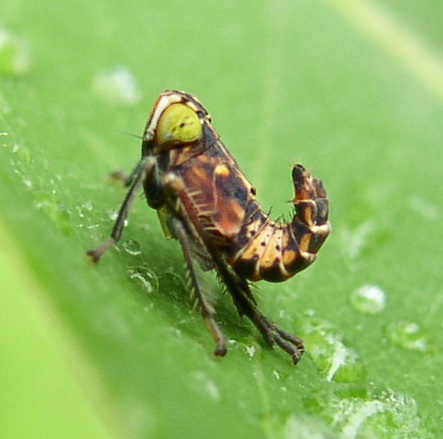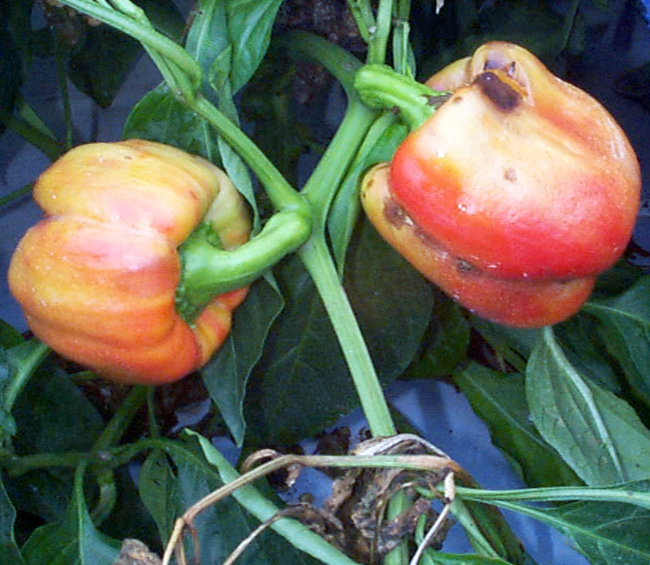|
Leafhoppers
A leafhopper is the common name for any species from the family Cicadellidae. These minute insects, colloquially known as hoppers, are plant feeders that suck plant sap from grass, shrubs, or trees. Their hind legs are modified for jumping, and are covered with hairs that facilitate the spreading of a secretion over their bodies that acts as a water repellent and carrier of pheromones. They undergo a partial metamorphosis, and have various host associations, varying from very generalized to very specific. Some species have a cosmopolitan distribution, or occur throughout the temperate and tropical regions. Some are pests or vectors of plant viruses and phytoplasmas. The family is distributed all over the world, and constitutes the second-largest hemipteran family, with at least 20,000 described species. They belong to a lineage traditionally treated as infraorder Cicadomorpha in the suborder Auchenorrhyncha, but as the latter taxon is probably not monophyletic, many m ... [...More Info...] [...Related Items...] OR: [Wikipedia] [Google] [Baidu] |
Brochosome
Brochosomes are intricately structured microscopic granules secreted by leafhoppers (the family Cicadellidae of the insect order Hemiptera) and typically found on their body surface and, more rarely, eggs. Brochosomes were first described in 1952 with the aid of an electron microscope. Brochosomes are hydrophobic and help keep the insect cuticle clean. These particles have also been found in samples of air and can easily contaminate foreign objects, which explains erroneous reports of brochosomes on other insects.Rakitov R.A. (2011Contamination as the cause of erroneous records of brochosomes.''Psyche: A Journal of Entomology '' 2011, Article ID 767963, . Structure and composition The name, derived from the Greek words ''βρóχoς'' ("brochos": mesh of a net) and ''σωμα'' ("soma": body), refers to the characteristic reticulated surface of the granules. Most species of leafhoppers produce hollow spherical brochosomes, 0.2–0.7 micrometres in diameter, with a honeycombed ... [...More Info...] [...Related Items...] OR: [Wikipedia] [Google] [Baidu] |
Phytoplasma
Phytoplasmas are obligate intracellular parasites of plant phloem tissue and of the insect vectors that are involved in their plant-to-plant transmission. Phytoplasmas were discovered in 1967 by Japanese scientists who termed them mycoplasma-like organisms. Since their discovery, phytoplasmas have resisted all attempts at ''in vitro'' culture in any cell-free medium; routine cultivation in an artificial medium thus remains a major challenge. Phytoplasmas are characterized by the lack of a cell wall, a pleiomorphic or filamentous shape, a diameter normally less than 1 μm, and a very small genome. Phytoplasmas are pathogens of agriculturally important plants, including coconut, sugarcane, and sandalwood, in which they cause a wide variety of symptoms ranging from mild yellowing to death. Phytoplasmas are most prevalent in tropical and subtropical regions. They are transmitted from plant to plant by vectors (normally sap-sucking insects such as leafhoppers) in which they both sur ... [...More Info...] [...Related Items...] OR: [Wikipedia] [Google] [Baidu] |
Eurymeloides Bicincta
''Eurymeloides bicincta'', commonly known as the two-lined gum-treehopper, is a leafhopper in the family Cicadellidae. It is the type species of the genus '' Eurymeloides''. It is a sap-sucking insect and is found on gum-trees in its native southeastern Australia. Description ''Eurymeloides bicincta'' grows to a length of about . The adult is wedge-shaped and is black with large orange eyes and white lines on its wings. The nymphs are orange. Ecology ''Eurymeloides bicincta'' is found on ''Eucalyptus'' trees where both nymphs and adults have piercing mouthparts and suck the sap. The excess fluid is secreted and is fed upon by ants which are often found associated with the leafhoppers. The ants do not harm the leafhoppers but may drive off potential predators. Some sand wasps in the tribe Nyssonini The Nyssonini are a group of cleptoparasitic bembicine wasps generally distinguished by the petiolate second submarginal cell of the forewing and rather strongly sculptured head ... [...More Info...] [...Related Items...] OR: [Wikipedia] [Google] [Baidu] |
Meat Ant
The meat ant (''Iridomyrmex purpureus''), also known as the gravel ant or southern meat ant, is a species of ant endemic to Australia. A member of the genus ''Iridomyrmex'' in the subfamily Dolichoderinae, it was described by British entomologist Frederick Smith in 1858. The meat ant is associated with many common names due to its appearance, nest-building behaviour and abundance, of which its specific name, ''purpureus'', refers to its coloured appearance. It is among the best-known species of ant found throughout Australia; it occurs in almost all states and territories except for Tasmania. Its enormous distribution, aggression and ecological importance have made this ant a dominant species. The meat ant is monomorphic (occurs in a particular form), although there is evidence that certain populations can be polymorphic. It is characterised by its dark-bluish body and red head. It is a medium to large species, measuring . The workers and males are approximately the same ... [...More Info...] [...Related Items...] OR: [Wikipedia] [Google] [Baidu] |
Auchenorrhyncha
The Auchenorrhyncha suborder of the Hemiptera contains most of the familiar members of what was called the "Homoptera" – groups such as cicadas, leafhoppers, treehoppers, planthoppers, and spittlebugs. The aphids and scale insects are the other well-known "Homoptera", and they are in the suborder Sternorrhyncha. Distributed worldwide, all members of this group are plant-feeders, and many are vectors of viral and fungal diseases of plants. It is also common for Auchenorrhyncha species to produce either audible sounds or substrate vibrations as a form of communication. Such calls range from vibrations inaudible to humans, to the calls of many species of cicadas that can be heard for hundreds of metres, at least. In season, they produce the most characteristic and ubiquitous noise of the bush. Etymology The word auchenorrhyncha is from the Greek αὐχήν, 'neck, throat' and ῥύγχος, 'snout'. Classification Debate and uncertainty as to whether the Auchenorrhy ... [...More Info...] [...Related Items...] OR: [Wikipedia] [Google] [Baidu] |
Plant Virus
Plant viruses are viruses that affect plants. Like all other viruses, plant viruses are obligate intracellular parasites that do not have the molecular machinery to replicate without a host. Plant viruses can be pathogenic to higher plants. Most plant viruses are rod-shaped, with protein discs forming a tube surrounding the viral genome; isometric particles are another common structure. They rarely have an envelope. The great majority have an RNA genome, which is usually small and single stranded (ss), but some viruses have double-stranded (ds) RNA, ssDNA or dsDNA genomes. Although plant viruses are not as well understood as their animal counterparts, one plant virus has become very recognizable: ''tobacco mosaic virus'' (TMV), the first virus to be discovered. This and other viruses cause an estimated US$60 billion loss in crop yields worldwide each year. Plant viruses are grouped into 73 genera and 49 families. However, these figures relate only to cultivated plants, which ... [...More Info...] [...Related Items...] OR: [Wikipedia] [Google] [Baidu] |
Eurymela Distincta
''Eurymela distincta'' is a species of leafhopper native to the Australian continent. It has a wedge-shaped body that is 10–12 mm long (adult male) or 12–14 mm long (adult female). The head is black with cream or white maxillary plates. The pronotum and scutellum are black. The tegmen is black with a blue or purple tinge, and one to three white fasciae. The costal margin is black. Legs are scarlet close to the body and black further away. Underparts are scarlet. ''E. distincta'' mainly feeds on the bangalay (''Eucalyptus botryoides'') and the apple box (''Eucalyptus bridgesiana''), though it has also been recorded on manna gum ('' E. viminalis''), black gum ('' E. aggregate'') and Camden woollybutt ('' E. macarthurii''). Nymphs and adults may be attended by up to 20 ants of the genus ''Iridomyrmex'', which also attend female scale insects of the species ''Eriococcus coriaceus'' and '' E. confusus'' that infest the same trees. The ants eat the leaf-hoppers' sugary ... [...More Info...] [...Related Items...] OR: [Wikipedia] [Google] [Baidu] |
Cicadellinae
CicadellinaeLatreille (1825) is a leafhopper subfamily in the family Cicadellidae. Selected genera * ''Bothrogonia ''Bothrogonia'' is a genus of leafhoppers with a large number of species distributed across the Old World. They can be told apart from others in their tribe by the pattern of setae on the hind tibia. References Hemiptera of Asia Cicade ...'' * '' Cicadella'' * '' Cofana'' * '' Graphocephala'' * '' Homalodisca'' * '' Zyzzogeton'' References External links Cicadellidae {{Cicadellinae-stub ... [...More Info...] [...Related Items...] OR: [Wikipedia] [Google] [Baidu] |
Eurymelinae
Eurymelinae is a subfamily of leafhoppers in the family Cicadellidae. Selected genera * ''Barolineocerus'' Freytag, 2008 * ''Eurymela'' Lepeletier & Serville, 1825 * '' Eurymelessa'' Evans, 1933 * '' Eurymelita'' Evans, 1933 * '' Eurymeloides'' Ashmead, 1889 * ''Idiocerus'' Lewis, 1834 * ''Oncopsis'' Burmeister, 1838 * ''Pediopsoides ''Pediopsoides'' is a genus of leafhopper A leafhopper is the common name for any species from the family Cicadellidae. These minute insects, colloquially known as hoppers, are plant feeders that suck plant sap from grass, shrubs, or trees. T ...'' Matsumura, 1912 References External links Cicadellidae {{Cicadellidae-stub ... [...More Info...] [...Related Items...] OR: [Wikipedia] [Google] [Baidu] |
Cicada0001
The cicadas () are a superfamily, the Cicadoidea, of insects in the order Hemiptera (true bugs). They are in the suborder Auchenorrhyncha, along with smaller jumping bugs such as leafhoppers and froghoppers. The superfamily is divided into two families, the Tettigarctidae, with two species in Australia, and the Cicadidae, with more than 3,000 species described from around the world; many species remain undescribed. Cicadas have prominent eyes set wide apart, short antennae, and membranous front wings. They have an exceptionally loud song, produced in most species by the rapid buckling and unbuckling of drumlike tymbals. The earliest known fossil Cicadomorpha appeared in the Upper Permian period; extant species occur all around the world in temperate to tropical climates. They typically live in trees, feeding on watery sap from xylem tissue, and laying their eggs in a slit in the bark. Most cicadas are cryptic. The vast majority of species are active during the day as adu ... [...More Info...] [...Related Items...] OR: [Wikipedia] [Google] [Baidu] |
Metamorphosis
Metamorphosis is a biological process by which an animal physically develops including birth or hatching, involving a conspicuous and relatively abrupt change in the animal's body structure through cell growth and differentiation. Some insects, fish, amphibians, mollusks, crustaceans, cnidarians, echinoderms, and tunicates undergo metamorphosis, which is often accompanied by a change of nutrition source or behavior. Animals can be divided into species that undergo complete metamorphosis (" holometaboly"), incomplete metamorphosis (" hemimetaboly"), or no metamorphosis (" ametaboly"). Scientific usage of the term is technically precise, and it is not applied to general aspects of cell growth, including rapid growth spurts. Generally organisms with a larva stage undergo metamorphosis, and during metamorphosis the organism loses larval characteristics. References to "metamorphosis" in mammals are imprecise and only colloquial, but historically idealist ideas of transf ... [...More Info...] [...Related Items...] OR: [Wikipedia] [Google] [Baidu] |
Subfamily
In biological classification, a subfamily ( Latin: ', plural ') is an auxiliary (intermediate) taxonomic rank, next below family but more inclusive than genus. Standard nomenclature rules end subfamily botanical names with "-oideae", and zoological names with "-inae". See also * International Code of Nomenclature for algae, fungi, and plants The ''International Code of Nomenclature for algae, fungi, and plants'' (ICN) is the set of rules and recommendations dealing with the formal botanical names that are given to plants, fungi and a few other groups of organisms, all those "trad ... * International Code of Zoological Nomenclature * Rank (botany) * Rank (zoology) Sources {{biology-stub ... [...More Info...] [...Related Items...] OR: [Wikipedia] [Google] [Baidu] |







